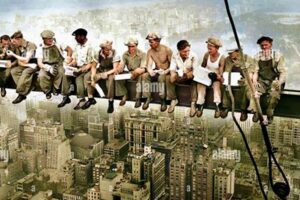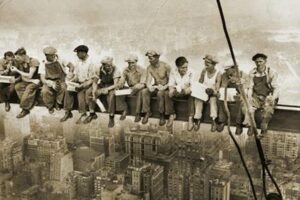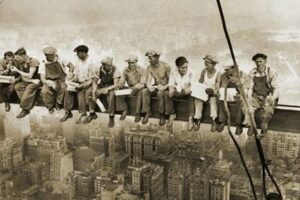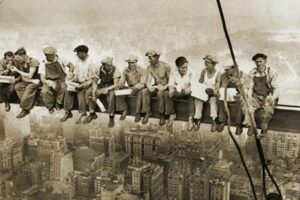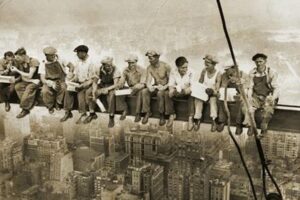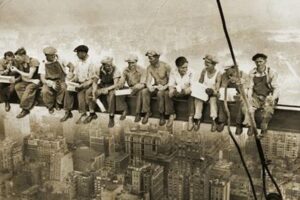Lunch atop a skyscraper, how did they not fall? is the caption of a famous photograph taken on September 20, 1932, during the construction of the RCA Building in New York City. The photograph shows eleven ironworkers sitting on a steel beam, eating lunch 840 feet (256 meters) above the ground. The photograph has become one of the most iconic images of the 20th century and is often used to represent the courage and determination of American workers.
The photograph was taken by Charles C. Ebbets, a photographer for the Bethlehem Steel Company. Ebbets was tasked with taking photographs of the construction of the RCA Building to promote the company’s steel products. Ebbets took several photographs of the ironworkers working on the building, but the photograph of the eleven ironworkers eating lunch is the most famous.
The photograph has been the subject of much debate over the years, with some people questioning whether it is real or staged. However, the photograph is believed to be authentic, and it provides a fascinating glimpse into the lives of the ironworkers who built some of the world’s most iconic skyscrapers.
1. Height
The height at which the “Lunch atop a Skyscraper” photograph was taken is a crucial factor in understanding how the ironworkers were able to remain safe while eating lunch on a narrow steel beam. The immense height presented several challenges and hazards:
- Wind: At such a great height, the wind could have easily knocked the workers off the beam. However, the workers were able to remain steady, likely due to a combination of their skill, experience, and the windbreak provided by the surrounding buildings.
- Balance: Maintaining balance on a narrow beam, hundreds of feet above the ground, required a high level of skill and concentration. The workers had to be able to shift their weight and move around the beam without losing their balance.
- Equipment: The workers were not wearing any safety harnesses or other protective gear, which increased the risk of falling. However, the workers were likely confident in their abilities and the strength of the steel beam.
Despite the dangers, the ironworkers were able to eat their lunch safely on the steel beam, thanks to their skill, experience, and courage. The “Lunch atop a Skyscraper” photograph is a reminder of the dangerous conditions that workers faced during the construction of skyscrapers in the early 20th century.
Conclusion: The height at which the “Lunch atop a Skyscraper” photograph was taken is a significant factor in understanding how the ironworkers were able to remain safe while eating lunch on a narrow steel beam. The immense height presented several challenges and hazards, but the workers were able to overcome these challenges thanks to their skill, experience, and courage.
2. Steel beams
The steel beam in the photograph “Lunch atop a Skyscraper” was a crucial component that allowed the ironworkers to eat their lunch safely at such a great height. The beam provided a stable and secure platform for the workers to sit on, despite its narrow and precarious appearance. Without the steel beam, the workers would have had to find another place to eat lunch, which would have been much more dangerous and difficult.
The steel beam also played an important role in protecting the workers from the wind. At 840 feet above the ground, the wind could have easily knocked the workers off the beam. However, the beam provided a windbreak that helped to keep the workers steady. This allowed the workers to eat their lunch without having to worry about being blown off the beam.
The use of steel beams in the construction of skyscrapers was a major innovation that allowed for the construction of taller and more stable buildings. Steel beams are strong and durable, and they can be used to create structures that are resistant to wind and other forces. The “Lunch atop a Skyscraper” photograph is a reminder of the importance of steel beams in the construction of skyscrapers and the role they played in keeping workers safe.
3. Safety harnesses
The absence of safety harnesses in the “Lunch atop a Skyscraper” photograph is a stark reminder of the dangerous conditions that ironworkers faced during the construction of skyscrapers in the early 20th century. Without the protection of safety harnesses, the workers were at risk of falling from great heights, which could have resulted in serious injury or death.
There are several reasons why the ironworkers in the photograph were not wearing safety harnesses. First, safety harnesses were not widely used in the construction industry at the time. In fact, the first full-body safety harness was not invented until 1935, three years after the “Lunch atop a Skyscraper” photograph was taken.
Second, even if safety harnesses had been available, it is not clear that the ironworkers would have used them. At the time, many ironworkers believed that safety harnesses were unnecessary and that they hindered their ability to work efficiently. As a result, many ironworkers chose to work without safety harnesses, despite the risks involved.
The absence of safety harnesses in the “Lunch atop a Skyscraper” photograph is a reminder of the importance of safety in the workplace. Today, safety harnesses are required by law in many workplaces, and they have helped to reduce the number of workplace accidents and fatalities. However, the photograph also serves as a reminder that safety cannot be taken for granted. Workers must always be aware of the risks involved in their jobs and take steps to protect themselves from injury.
4. Wind
The wind is a powerful force, especially at great heights. At 840 feet above the ground, the wind could have easily knocked the ironworkers off the beam in the “Lunch atop a Skyscraper” photograph. However, the workers remained steady, demonstrating their skill, experience, and courage.
There are several reasons why the wind did not knock the workers off the beam. First, the workers were sitting down, which gave them a lower center of gravity and made them less likely to be blown off the beam. Second, the workers were holding onto the beam with their hands, which helped to keep them secure. Third, the workers were wearing heavy clothing, which helped to protect them from the wind.
The ability of the workers to remain steady in the wind is a testament to their skill and experience. Ironworkers are highly trained professionals who are skilled at working at great heights. They are also experienced in dealing with the wind and other hazards that can be encountered when working on skyscrapers.
The “Lunch atop a Skyscraper” photograph is a reminder of the importance of safety when working at great heights. The workers in the photograph were able to remain safe thanks to their skill, experience, and courage. However, it is important to remember that working at great heights is always dangerous, and it is important to take all necessary safety precautions.
5. Trust
In the iconic photograph “Lunch atop a Skyscraper,” eleven ironworkers sit on a steel beam, eating lunch 840 feet above the ground. The photograph has become a symbol of the courage and determination of American workers, but it also raises questions about how the workers were able to remain safe while sitting on a narrow beam so high above the ground.
One of the most important factors that kept the workers safe was their trust in their own skills and the strength of the steel beam. The workers were highly skilled ironworkers who had years of experience working at great heights. They knew how to balance on a narrow beam and how to hold on tight in the wind. They also trusted that the steel beam was strong enough to support their weight.
This trust was well-founded. The steel beam was made of high-quality steel and was securely bolted to the building. The workers also took precautions to make sure that the beam was stable, such as by placing wooden planks underneath it.
The workers’ trust in their skills and the strength of the steel beam was essential to their safety. Without this trust, they would not have been able to remain calm and collected while sitting on a narrow beam so high above the ground.
The “Lunch atop a Skyscraper” photograph is a reminder of the importance of trust in the workplace. When workers trust their own skills and the equipment they are using, they are more likely to be safe and productive.
6. Courage
The iconic photograph “Lunch atop a Skyscraper” captures the courage of eleven ironworkers sitting on a steel beam, eating lunch 840 feet above the ground. The photograph has become a symbol of the courage and determination of American workers, but it also raises questions about how the workers were able to remain safe while sitting on a narrow beam so high above the ground.
One of the most important factors that kept the workers safe was their courage. The workers were not wearing any safety harnesses or other protective gear, so they relied on their own courage and skill to stay safe. They had to be able to balance on the narrow beam and hold on tight in the wind. They also had to be able to remain calm and collected in the face of danger.
The workers’ courage was essential to their safety. Without their courage, they would not have been able to remain safe while sitting on a narrow beam so high above the ground.
The courage of the ironworkers in the “Lunch atop a Skyscraper” photograph is an inspiration to us all. It shows us that anything is possible if we have the courage to face our fears and pursue our dreams.
Conclusion: The courage of the ironworkers in the “Lunch atop a Skyscraper” photograph is a reminder that courage is essential for success. When we have the courage to face our fears and pursue our dreams, anything is possible.
7. Skill
The photograph “Lunch atop a Skyscraper” captures eleven ironworkers sitting on a steel beam, eating lunch 840 feet above the ground. The photograph has become a symbol of the courage and determination of American workers, but it also raises questions about how the workers were able to remain safe while sitting on a narrow beam so high above the ground.
One of the most important factors that kept the workers safe was their skill and experience. The workers were highly skilled ironworkers who had years of experience working at great heights. They knew how to balance on a narrow beam and how to hold on tight in the wind. They also knew how to work together as a team to get the job done safely.
The skill and experience of the ironworkers in the “Lunch atop a Skyscraper” photograph is an example of how important skill and experience are in any job. When workers are skilled and experienced, they are more likely to be able to work safely and efficiently. This is especially important in jobs that are dangerous or require a high level of precision.
The skill and experience of the ironworkers in the “Lunch atop a Skyscraper” photograph is also a reminder that safety should always be a top priority in the workplace. Employers should provide their workers with the training and equipment they need to work safely. Workers should also be aware of the risks involved in their jobs and take steps to protect themselves from injury.
Conclusion: The skill and experience of the ironworkers in the “Lunch atop a Skyscraper” photograph is a reminder that skill and experience are essential for safety in the workplace. Employers should provide their workers with the training and equipment they need to work safely, and workers should be aware of the risks involved in their jobs and take steps to protect themselves from injury.
8. Planning
The iconic photograph “Lunch atop a Skyscraper” captures a moment of camaraderie and daring during the construction of the RCA Building in New York City in 1932. The image raises questions about the safety measures and techniques used to protect workers during the construction of skyscrapers, and one crucial factor was careful planning and coordination.
Planning is essential to ensure the safety of workers at any construction site, but it is especially critical when working at great heights. The construction of skyscrapers involves numerous complex tasks, and each task must be carefully planned and coordinated to avoid accidents. For example, the materials and equipment needed to construct a skyscraper must be carefully planned and coordinated to ensure that they are available when and where they are needed. The sequence of construction activities must also be carefully planned to avoid delays and potential hazards.
In the case of the “Lunch atop a Skyscraper” photograph, the workers were sitting on a steel beam 840 feet above the ground. This would have been an extremely dangerous situation if not for the careful planning and coordination that went into the construction process. The steel beam was securely bolted to the building, and the workers were using safety lines to protect themselves from falling. The workers were also wearing hard hats and other protective gear.
The careful planning and coordination that went into the construction of the RCA Building is a reminder that safety should always be a top priority in the workplace. By carefully planning and coordinating all aspects of the construction process, employers can help to ensure the safety of their workers.
Conclusion: Planning is essential to ensure the safety of workers in any industry, but it is especially critical in the construction industry. By carefully planning and coordinating all aspects of the construction process, employers can help to prevent accidents and injuries.
9. Legacy
The photograph “Lunch atop a Skyscraper” is a powerful symbol of the skill, courage, and determination of the workers who built America’s skyscrapers. The photograph captures a moment of camaraderie and daring during the construction of the RCA Building in New York City in 1932. The workers in the photograph are sitting on a steel beam, eating lunch 840 feet above the ground. The photograph is a reminder of the dangerous conditions that workers faced during the construction of skyscrapers in the early 20th century. It is also a reminder of the skill and courage of the workers who built America’s iconic skyscrapers.
The legacy of the “Lunch atop a Skyscraper” photograph is that it continues to inspire people today. The photograph is a reminder of the importance of hard work, dedication, and teamwork. It is also a reminder of the importance of safety in the workplace. The photograph has been used in numerous safety campaigns and has helped to raise awareness of the importance of workplace safety.
The “Lunch atop a Skyscraper” photograph is a powerful symbol of the American spirit. It is a reminder of the can-do attitude that has made America great. The photograph is a reminder that anything is possible if you have the skill, courage, and determination to achieve it.
FAQs about “Lunch atop a Skyscraper
This section addresses common questions and misconceptions surrounding the iconic photograph “Lunch atop a Skyscraper.”
Question 1: Was the “Lunch atop a Skyscraper” photograph staged?
Answer: No, the photograph is believed to be authentic. There is no evidence to suggest that the photograph was staged, and the workers in the photograph have been identified.
Question 2: How high above the ground were the workers sitting?
Answer: The workers were sitting on a steel beam 840 feet (256 meters) above the ground.
Question 3: Why weren’t the workers wearing safety harnesses?
Answer: Safety harnesses were not widely used in the construction industry at the time the photograph was taken. Additionally, some ironworkers believed that safety harnesses hindered their ability to work efficiently.
Question 4: How did the workers remain steady in the wind?
Answer: The workers were sitting down, which gave them a lower center of gravity. They were also holding onto the beam with their hands and wearing heavy clothing, which helped to protect them from the wind.
Question 5: What is the significance of the “Lunch atop a Skyscraper” photograph?
Answer: The photograph is a powerful symbol of the skill, courage, and determination of the workers who built America’s skyscrapers. It is also a reminder of the importance of safety in the workplace.
Question 6: How did the “Lunch atop a Skyscraper” photograph impact workplace safety?
Answer: The photograph helped to raise awareness of the importance of workplace safety. It has been used in numerous safety campaigns and has inspired the development of new safety regulations.
Summary: The “Lunch atop a Skyscraper” photograph is a powerful reminder of the skill, courage, and determination of the workers who built America’s skyscrapers. It is also a reminder of the importance of safety in the workplace. The photograph continues to inspire people today and is a valuable tool for promoting workplace safety.
Transition: The “Lunch atop a Skyscraper” photograph is a fascinating and iconic image that has captured the imagination of people around the world. It is a reminder of the skill, courage, and determination of the workers who built America’s skyscrapers. It is also a reminder of the importance of safety in the workplace.
Tips for Preventing Falls from Heights
Falls from heights are a major cause of serious injuries and death in the construction industry. The “Lunch atop a Skyscraper” photograph is a reminder of the importance of safety when working at great heights. Here are five tips to help prevent falls from heights:
Tip 1: Use fall protection equipment. Fall protection equipment includes items such as safety harnesses, lanyards, and lifelines. This equipment is designed to catch you if you fall, and it can help to prevent serious injuries or death.
Tip 2: Inspect your fall protection equipment regularly. Fall protection equipment can be damaged over time, so it is important to inspect it regularly to make sure it is in good working condition.
Tip 3: Train your workers on how to use fall protection equipment. Workers need to be trained on how to properly use fall protection equipment in order to be safe.
Tip 4: Plan your work carefully. Before you start working at a height, take the time to plan your work carefully. This includes identifying potential hazards and developing a plan to mitigate those hazards.
Tip 5: Supervise your workers closely. When workers are working at a height, it is important to supervise them closely to make sure they are following safety procedures.
Summary: By following these tips, you can help to prevent falls from heights and keep your workers safe.
Transition to the article’s conclusion: Falls from heights are a serious hazard in the construction industry. By taking the necessary precautions, you can help to prevent these accidents and keep your workers safe.
Conclusion
The “Lunch atop a Skyscraper” photograph is a powerful reminder of the skill, courage, and determination of the workers who built America’s skyscrapers. It is also a reminder of the importance of safety in the workplace. By taking the necessary precautions, we can help to prevent falls from heights and keep our workers safe.
Falls from heights are a serious hazard in the construction industry, but they can be prevented. By following the tips outlined in this article, you can help to create a safe work environment for your workers.


